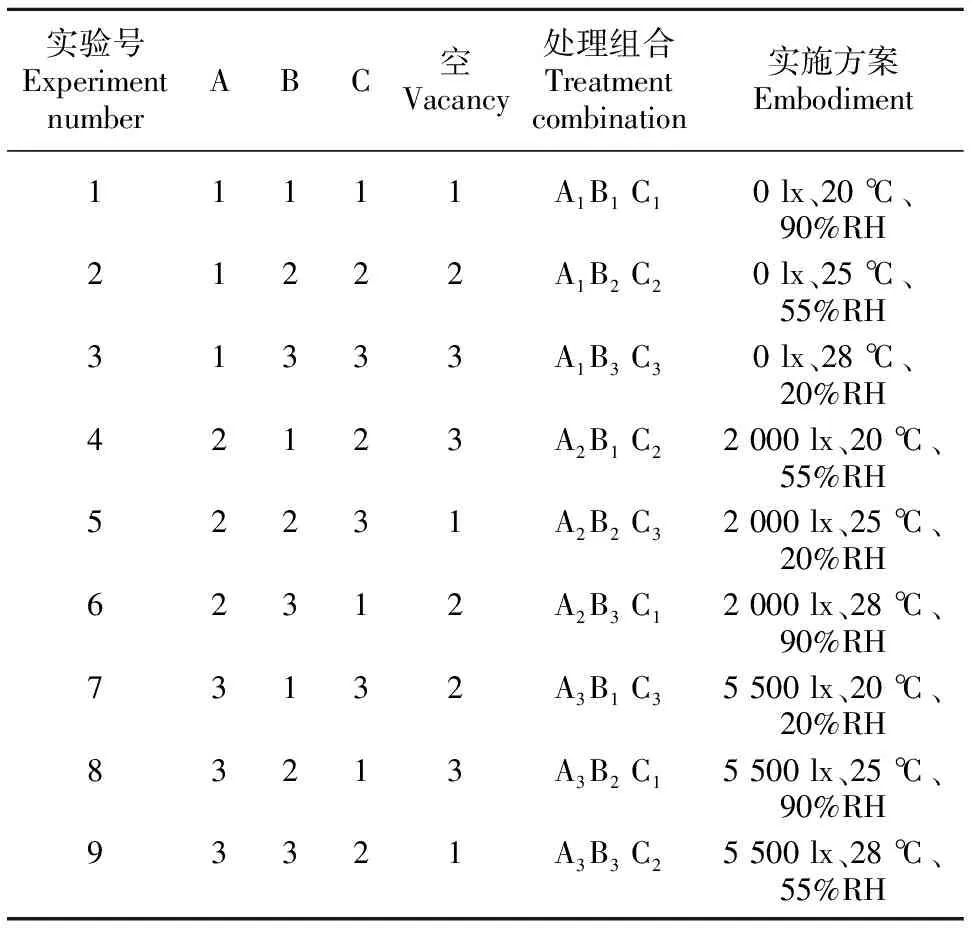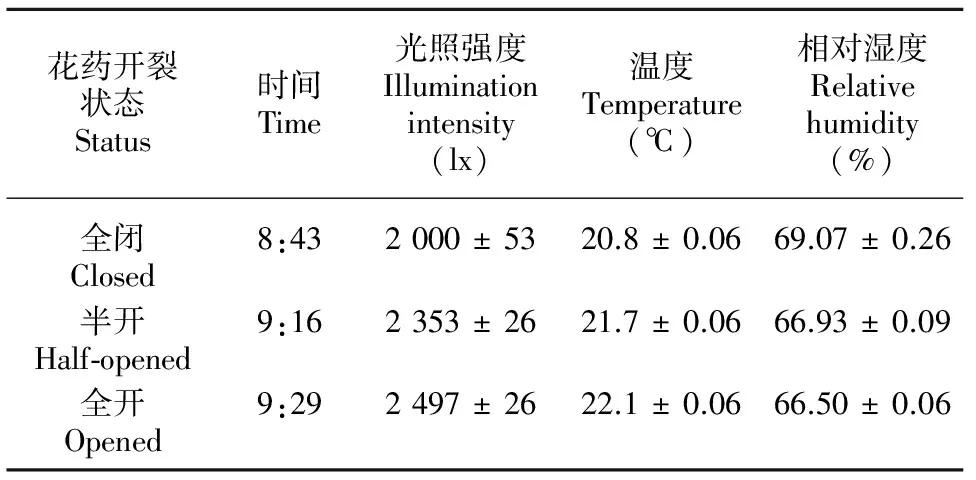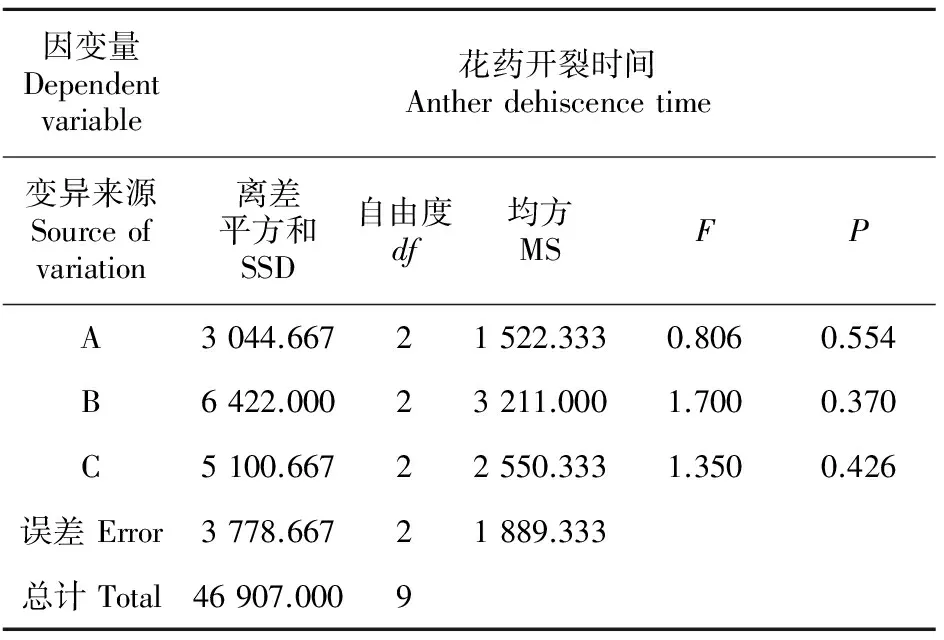生态因子对滇重楼花药开裂的影响
2016-11-11尹芳园耿开友侯秀丽王定康
赵 峥,尹芳园,耿开友,侯秀丽,王 斌,王定康
( 昆明学院,昆明 650214 )
生态因子对滇重楼花药开裂的影响
赵峥,尹芳园,耿开友,侯秀丽,王斌,王定康*
( 昆明学院,昆明 650214 )
滇重楼为延龄草科重楼属植物,具有极高的药用价值,由于重楼传统药用部位生长缓慢、繁殖力低下,以及人们对野生重楼资源的过度采挖使其资源日趋枯竭。滇重楼的花药在整个花期中存在开裂-关闭的现象,花药的有效闭合应是保护花粉、延长花粉寿命、增强雄性适合度的一种适应机制。该研究以滇重楼为对象,通过设计正交实验和对比实验,观测其花药开裂过程中的光照强度、温度、湿度的变化,探究光照强度、温度、湿度等生态因子对滇重楼花药开裂的影响以及滇重楼花药开裂与生态因子变化的关系。结果表明:(1)在滇重楼花药开裂的过程中,光照强度增强、温度升高、相对湿度下降;(2)温度是影响滇重楼花药开裂时间的主导因子,升温促进花药开裂,降温促进花药关闭;(3)高湿度及黑暗推迟花药开裂,但并不能阻止花药开裂;(4)低温可使滇重楼花药持续关闭,而光照强度越高,花药持续关闭所需的温度越低。该研究有利于解释滇重楼花药白天开裂夜晚关闭的现象与环境因子的关系,对滇重楼的栽培育种提供理论指导。
滇重楼, 生态因子, 花药开裂
滇重楼(Parispolyphyllavar.yunnanensis)为延龄草科(Trilliaceae)重楼属(ParisL.)多年生宿根性草本植物,主要分布于我国云、贵、川等地,是一种珍贵的药用植物,具有极高的药用价值(李恒,1998)。由于重楼传统药用部位根茎生长缓慢、繁殖力低下,以及人们对野生重楼资源的过度采挖使得重楼资源日趋枯竭(苏文华等,2003;李运昌,1982;袁理春等,2003;黄玮等,2008;陆辉等,2006)。
植物开花后花药必须及时开裂才能保证正常散粉,花药开裂为花药发育过程中需经历的最后一个阶段。花药开裂和花粉释放一直是植物生殖生物学研究的热点问题之一。花药开裂是一个多级的过程,涉及药壁细胞结构分化、退化,内源激素变化,加上花药组织脱水促进花药完全开放和花粉释放(Keijzer,1987;Wilson et al,2011),而且低的相对湿度促进花药开裂,高的相对湿度推迟或抑制花药开裂过程(Linskenshf,1988;Yates et al,1993;Liscim & Pacini,1994)。现在普遍认为天气足够温暖和干燥有利于花药开裂(Faegri & Vander,1979),花药的开裂受光照、温度、湿度等生态因子影响(Wang et al,2009;毕廷菊等,2012)。滇重楼的花药在正常天气情况下,整个花期中均存在每天上午开裂、傍晚关闭,下雨关闭、雨后开裂的现象(王定康等,2008)。而花药在整个花期中的有效闭合是保护花粉、延长花粉寿命、增强雄性适合度的一种适应机制(王定康等,2008;Li et al,2012)。滇重楼花药开裂伴随着气温的升高和空气湿度的降低,花药开裂和关闭现象与光照、温度和湿度均有关(Wang et al,2009)。滇重楼花药开裂现象与生态因子变化的关系有待进一步研究。本文通过一系列实验来研究光照强度、温度、湿度、光质等生态因子对滇重楼花药开裂行为及花药开裂时间的影响情况。
1 材料与方法
1.1 研究地概况及实验材料
试验地位于昆明学院农学院(25°03′ N,102°43′ E),年均气温为15.1 ℃,年均降雨量为1 075 mm,海拔1 891 m,属低纬高原山地季风气候。滇重楼于2014年3月种植在遮荫棚中,遮阴率约为75%,株行距15 cm × 25 cm,正常水肥管理。
1.2 方法
1.2.1 花药开裂过程观察对植株进行标记,观察花药开裂情况并记录相应的时间、温度、湿度、光照强度。用SPSS软件计算均值。因单朵花内最先完全开裂和最后完全开裂的单枚花药开裂时间相差不到1 min,因此取50%花药完全开裂的时间作为其花药开裂的时间,下同。
1.2.2 花药开裂生态因子影响实验实验在BIC-300人工气候箱中进行实验。每组实验开始前将实验植株置于环境条件设置为15 ℃、黑暗、70%RH 的BIC-300人工气候箱中4.5 h,使其花药处于持续关闭的状态。1.2.2.1 正交实验实验设光照强度(A)、温度(B)和湿度(C)3个因素,根据自然状态滇重楼花药开裂时的生态因子数值设定因素水平,每个因素包括3个水平(表1)。采用L9(34)的正交表进行正交实验,因素A、B、C分别排列于第1、2、3列,第4列为空列(表2)。记录这9个处理组合下花药开裂时间。采用直观分析法了解因素的主导效应及其优水平组合,用SPSS软件进行交互作用分析及因素间的方差分析。1.2.2.2 温度对比实验在光照强度均为2 000 lx,相对湿度均为45%~65%,温度分别为12、17、20、21、22、23、24 ℃的条件下进行对比实验。

表 1 实验的因素水平表

表 2 L9(34)正交试验因素水平表及试验实施
1.2.2.3 光照强度对比实验在湿度均为45%~65%,温度为24 ℃、光照强度分别为100、1 000、3 000、5 500 lx的环境条件下进行对比实验,观察花药开裂过程并记录花药开裂时间。
2 结果与分析
2.1 花药开裂时间及开裂过程中生态因子的变化
滇重楼的花药具有每天上午开裂、晚上关闭的特性,其花药开裂-关闭的同时伴随着光照强度、温度、湿度的变化。观测发现上午8:43~9:29滇重楼花药开裂,花药开裂过程中温度升高1.3 ℃,相对湿度降低2.57%,光照强度升高496.7 lx。整个花药开裂过程所需时间均为46 min;在滇重楼花药开裂的过程中,其全闭、半开、全开时的光照强度分别为(2 000 ± 53)、(2 353 ± 26)、(2 497 ± 26) lx;温度分别为(20.8 ± 0.06)、(21.7 ± 0.06)、(22.1 ± 0.06)℃;相对湿度分别为(69.07 ± 0.26)%、(66.93 ± 0.09)%、(66.5 ± 0.06)%。
2.2 生态因子对滇重楼花药开裂的影响
2.2.1 L9(34)正交实验结果及分析处理组合1-9滇重楼花药完全开裂所需时间分别为182、34、31、54、42、36、45、52、31 min(图1)。

表 3 滇重楼花药开裂时间及生态因子变化

图 1 不同处理组合滇重楼花药开裂时间Fig. 1 Anther dehiscence time of Paris polyphylla var. yunnanensis under different treatment combinations
实验结果很明显分为二类,处理组合1为一类,其余处理组合聚为一类。处理1光照强度、温度最低,湿度最高,大大延长了花药开裂时间;处理组合4、5、7、8的花药开裂时间最接近自然状态值,处理组合2、3、6、9的花药开裂时间偏短,其温度值均高于自然状态值。
对实验结果按直观分析法进行分析(表4)。极差R分析结果为RB>RC>RA;表明各因素对滇重楼花药开裂时间的影响主次顺序为温度>相对湿度>光照强度,即温度为影响滇重楼花药开裂时间的主要因子。各因素最优水平分别为A3、B3和C3,即滇重楼花药开裂时间最短的光照强度、温度及相对湿度为5 500 lx、28 ℃、20 RH。

表 4 L9(34)正交实验结果的直观分析
用SPSS软件进行交互作用分析(图2)。A × B、B × C、A × C交互作用图中,三条曲线的斜率相等,基本没有交互作用。从图中还可以看出:光照强度A由水平1到水平2花药开裂时间变化大,由水平2到水平3的折线近乎水平,花药开裂时间变化非常小;说明黑暗可以推迟花药开裂,而有光照时,光照强度的强弱对花药开裂时间影响甚微。温度B由水平1到水平2花药开裂时间变化大,由水平2到水平3花药开裂时间变化较小,但依然有明显变化。而C2、C3的两条线几乎重合说明湿度从水平2到水平3花药开裂时间几乎不变,湿度从水平1到水平2花药开裂时间变化较大。这验证了Wang et al(2009)的湿度对花药开裂时间影响的结论:高湿度推迟花药开裂,中低湿度对花药开裂时间无影响。对比3个交互作用图可以看出,温度由B1到B2到B3花药开裂时间的变化明显大于光照强度由A1到A2到A3花药开裂时间的变化,这验证了极差分析中温度对花药开裂时间影响程度大于光照强度对花药开裂时间的影响。
为进一步了解因素水平间影响花药开裂时间的差异显著性,对其水平进行单因变量多因素的方差分析(表5)。表5结果显示,实验中光照强度、温度、相对湿度各水平对花药开裂时间无显著影响。但是从处理组合1可以看出黑暗、低温、高湿的环境能够大大延长花药开裂时间,而处理组合2、3表明黑暗可以使滇重楼花药正常开裂,处理组合6、8表明极端高湿也可以使滇重楼花药正常开裂。
由于滇重楼花期内昆明市的夜间温度常低于20 ℃,低温是否调控着滇重楼花药夜间关闭不得而知,故进一步增加温度及光照强度水平进行对比实验。

表 5 因素的水平间花药开裂时间的方差分析
注:P<0.05表示差异显著,P<0.01表示差异极显著。
Note:P<0.05 means significant difference,P<0.01 means extremely significant difference.
2.2.2温度对滇重楼花药开裂的影响从图3可以看出,在2 000 lx、55% RH的环境条件下,≤17 ℃时花药开裂时间>12 h,20、21、22、23、24 ℃时花药开裂时间分别为90、58、45、35、30 min,花药开裂时间随着温度的升高而明显缩短,在2 000 lx、55% RH时,滇重楼花药在1 h之内开裂的最低温度为21 ℃,高于这个温度其花药可以正常开裂,否则将长时间保持关闭状态。2.2.3光照强度对滇重楼花药开裂的影响图3结果显示,在45%~65% RH、24 ℃,光照强度为100、1 000、3 000、5 500 lx时,花药均能开裂,开裂时间分别为28、24、24、22 min。当温度为24 ℃时,温湿度相同、光照强度越大,花药开裂时间越短,但是相差不明显。
3 讨论
温度的变化是影响滇重楼花药开裂时间的主导因子,高湿度及黑暗推迟花药开裂,但并不能阻止花药开裂,而中低湿度及有光照时的不同光照强度对花药开裂时间几乎无影响。不同温度的对比实验证实在一定光照强度、相对湿度条件下,低温能够使得花药12 h持续不开裂,符合现在普遍认为花药只有在天气足够温暖和干燥,能够便于传粉时才会开裂的观点(Faegri et al,1979)。而光照强度越高,要使花药持续不开裂所需温度越低。
综上所述,可以解释滇重楼花药白天开裂夜晚关闭的现象与环境因子的关系:白天光照强度由0逐渐增强,使得花药开裂的最低温要求降低,解除黑暗对花药开裂的推迟作用;同时,温度不断升高,湿度不断下降解除高湿度对花药开裂的推迟作用,随着温度升高到足以使花药正常开裂的温度,花药便逐渐开裂;而夜晚温度迅速降低并不断降低,使得花药关闭并整晚保持持续关闭状态,光照强度的减弱直至黑暗使得花药开裂的最低温升高,从而促进花药的关闭。

图 2 光照强度-温度、温度-相对湿度、光照强度-相对湿度的交互作用图Fig. 2 Interaction between pair wise of light intensity, temperature and relative humidity

图 3 不同温度下滇重楼花药开裂时间Fig.3 Paris polyphylla var. yunnanensis anther dehiscence time at different temperatures
植物开花及花药开裂、散粉对植物繁殖和育种具有重要意义。滇重楼花药的适时开裂是保护花粉、延长花粉寿命、增强雄性适合度的一种适应机制(王定康等,2008),通过控制光照强度、温度、湿度、光质等环境因子对滇重楼花药开裂行为及花药开裂时间实现人为调控,为滇重楼的繁殖栽培、选种育种提供重要支持。
BI TJ, ZHOU HP, SU ZL, et al, 2012. Light effects on the style curvature and anther dehiscence ofAlpiniamutica(Zingiberaceae) [J]. Plant Divers Resour, 34(5): 453-458. [毕廷菊,周会平,苏志龙,等,2012. 光对马来良姜花柱运动和花药开裂的影响 [J]. 植物分类与资源学报,34(5):453-458.]
FAEGRI K, VANDER PL, 1979. The principles of pollination ecology [M]. Oxford: Pergamon Press: 42.
HUANG W, MENG FY, ZHANG WS, et al, 2008. Study on seed dormancy mechanism ofParispolyphyllavar.yunnanensis[J]. Chin Agric Sci Bull, 24(12): 242-246. [黄玮,孟繁蕴,张文生,等,2008. 滇重楼种子休眠机理研究 [J].中国农学通报,24(12):242-246.]
KEIJZER C, 1987. The processes of anther dehiscence and pollen dispersal. I. The openingmechanism of longitudinally dehiscing anthers [J]. New Phytol, 105: 487-498.
LINSKENSHF C, 1988. The effect of temperature humidity and lighton the dehiscence of tobacco anthers [C]. Proceedings of the Koninklijke Neder-landse Akademie van Wetenschappen C, 91: 369-375.
LISCIM TC, PACINI E, 1994. Pollination ecophysiology ofMercurialisannuaL.(Euphorbiaceae), an anemophilous species flowering all year round [J]. Ann Bot, 74:125-135.
LI H,1998. The genusParis(Trilliaceae) [M]. Beijing: Science Press:35-36. [李恒,1998. 重楼属植物 [M]. 北京:科学出版社:35-36.]
LI J, WANG QF, GITURUC RW, et al, 2012. Reversible anther opening enhances male fitness in a dichogamous aquatic plantButomusumbellatusL., the flowering rush [J]. Aquat Bot, 99: 27-33.
LI YC,1982. Studies on the introduction cultivation ofGenusParisL. I. A preliminary report on sexual propagation ofParispolyphyllavar.Yunnanensis[J]. Acta Bot Yunnan, 4(4): 429-431. [李运昌,1982. 重楼属植物引种栽培的研究Ⅰ.滇重楼的有性繁殖试验初报 [J].云南植物研究,4(4):429-431.]
LU H, XU JH, CHEN RP, et al, 2006. Status of the genusParisL. resources of Yunnan and countermeasures for protection [J]. J Yunnan Univ: Nat Sci Ed, 28(S1): 307-310. [陆辉,许继宏,陈锐平,等,2006. 云南重楼属植物资源现状与保护对策 [J].云南大学学报·自然科学版,28(S1):307-310. ]
SU WH, ZHANG GF,2003. Relation between the photosynthesis ofParispolyphyllavar.Yunnanensisand the environmental factors [J]. J Yunnan Univ: Nat Sci Ed, 25(6): 545-548. [苏文华,张光飞,2003. 滇重楼光合作用与环境因子的关系 [J].云南大学学报·自然科学版,25(6):545-548.]
WANG DK, SUN GF, GUO LH, et al, 2008. Observation on the anther opening and closing phenomena of several species ofParisGenus[J]. J Anhui Agric Sci, 36 (9): 3709-3710. [王定康,孙桂芳,郭丽红,等,2008.几种重楼属植物花药开裂和关闭现象的研究 [J].安徽农业科学,36 (9):3709-3710. ]
WANG DK, SUN GF, WANG LF, et al, 2009. A novel mechanism controls anther opening and closing inParispolyphyllavar.Yunnanensis[J]. Chin Sci Bull, 54 (2): 244-248.
WILSON ZA, SONG J, TAYLOR B, et al, 2011. The final split: the regulation of anther dehiscence [J]. J Exp Bot,62(5): 1633-1649.
YATES IE, SPARKS D, 1993. Environmental regulation of anther dehiscence and pollen germination in pecan [J]. J Am Soc Hortic Sci, 118: 699-706.
YUAN LC, CHEN C, YANG LY, et al, 2003. Effects of temperature and gibberellin treatments on the second growth of seeds ofParispolyphyllavar.yunnanensis[J]. Seed, 21(5): 33-34. [袁理春,陈翠,杨丽云,等,2003. 温度和赤霉素对滇重楼种子二次发育的影响 [J].种子,21(5):33-34.]
Effects of ecological factors on anther dehiscence ofParispolyphyllavar.yunnanensis
ZHAO Zheng,YIN Fang-Yuan,GENG Kai-You,HOU Xiu-Li,WANG Bin,WANG Ding-Kang*
( Kunming University, Kunming 650214,China )
Parispolyphyllavar.yunnanensisto Trilliaceae plants, have a very high medicinal value, because of the traditional medicinal part slow growth and low fertility. Due to the excessive excavation of the resources of wildP.polyphyllavar.yunnanensisexcessive excavation, the resource is dried up. Anther dehiscence is a multistage process involving localized cellular differentiation and degeneration, combined with changes to the structure and water status of the anther to facilitate complete opening and pollen release. Jasmonic acid has been shown to be a critical signal for dehiscence, although other hormones, particularly auxin, are also involved. Anther dehiscence is affected by light, temperature, humidity and other ecological factors.P.polyphyllavar.yunnanensisof anther in the entire flowering cracking-closure phenomenon, anther effective closure should protect pollen, for extend the service life of pollen, the increase of a male fitness adaptation mechanism. We observed the effects of ecological factors, light intensity, temperature, humidity changes in anther dehiscence process ofP.polyphyllavar.yunnanensis. The effects of ecological factors such as light intensity, temperature, relative humidity and light quality on the anther dehiscence ofP.polyphyllavar.yunnanensiswere studied by comparing experiments and orthogonal experiments. The main experimental results were as follows: Light intensity and temperature increased, humidity droped in the process of anther dehiscence ofP.polyphyllavar.yunnanensis; Temperature was the main factor affecting anther dehiscence, temperature increasing encouraged anther opening and temperature decreasing encouraged anther closing; Dark and high humidity delayed anther dehiscence, but it did not prevent anther dehiscence; Low temperature kept anther remaining closed for a long time and increasing light intensity could reduce the temperature limiting anther dehiscence. The study explains the relationship between environmental factors and the phenomenon of anther opening in the daytime and closing at night,and provides the information for cultivation and breeding ofP.polyphyllavar.yunnanensis.
Parispolyphyllavar.yunnanensis, ecology factor, anther dehiscence
10.11931/guihaia.gxzw201510029
2015-11-26
2016-01-17
国家自然科学基金(31260073) [Supported by the National Natural Science Foundation of China(31260073)] 。
赵峥(1980-),女,云南昆明人,博士,副教授,主要从事植物繁殖生物学研究,(E-mail)zhaozheng2118@163.com。
王定康,博士,教授,从事植物繁殖生物学研究,(E- mail)wdk117@163.com。
Q948.1
A
1000-3142(2016)10-1192-06
赵峥,尹芳园,耿开友,等. 生态因子对滇重楼花药开裂的影响 [J]. 广西植物,2016,36(10):1192-1197
ZHAO Z,YIN FY,GENG KY,et al. Effects of ecological factors on anther dehiscence ofParispolyphyllavar.yunnanensis[J]. Guihaia,2016,36(10):1192-1197
